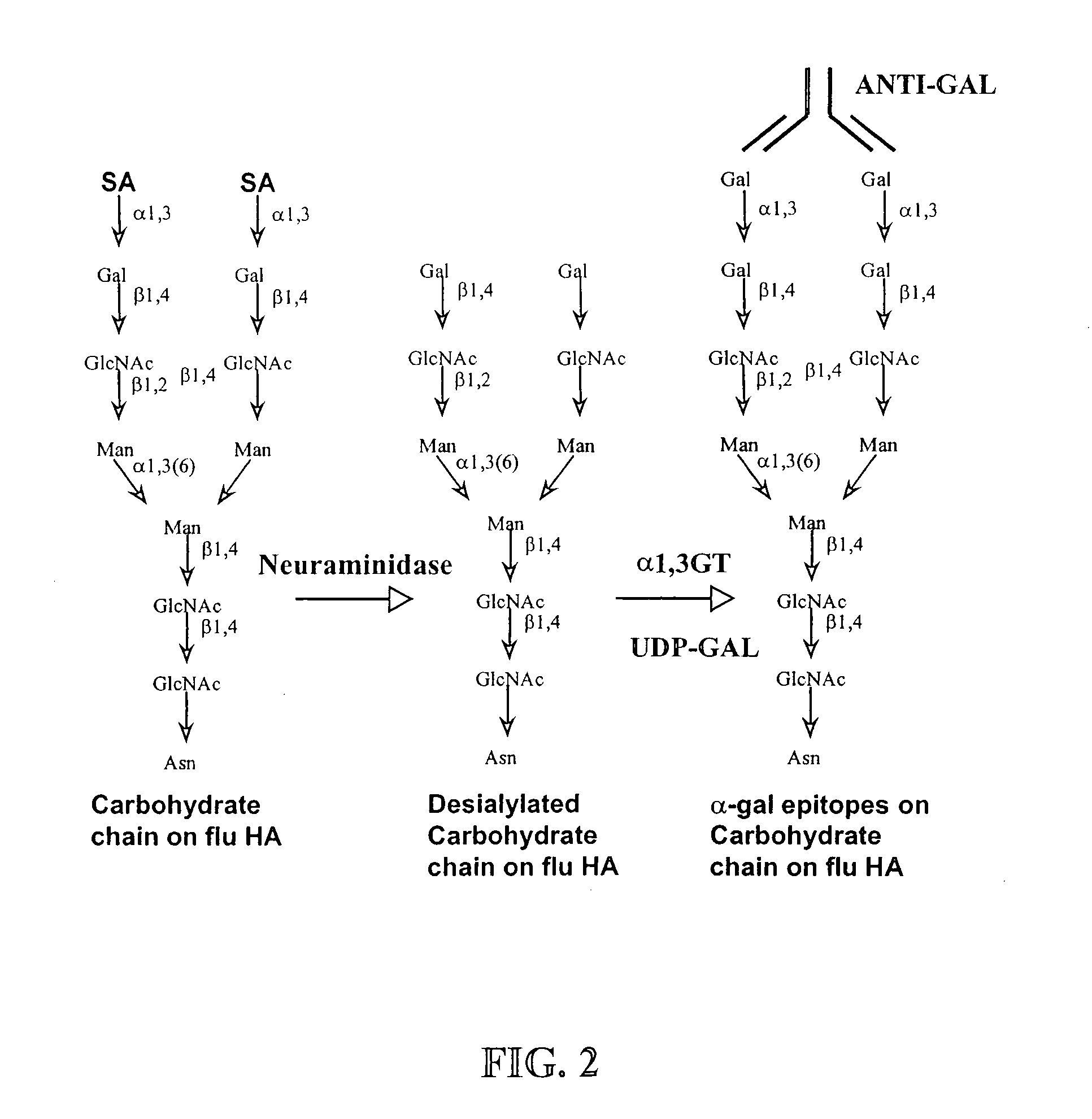Compositions and methods for increasing immunogenicity of glycoprotein vaccines
a glycoprotein and immunogenicity technology, applied in the field of microbial vaccines, can solve the problems of low immunogenicity, significant risk, severe illness and even death, etc., and achieve the effects of enhancing humoral and cellular immune responses, increasing the immunogenicity of microbial peptides, and enhancing targeting of virions
- Summary
- Abstract
- Description
- Claims
- Application Information
AI Technical Summary
Benefits of technology
Problems solved by technology
Method used
Image
Examples
example 1
In Vitro Synthesis of α-Gal Epitopes to Produce PR8αgal
[0084]This example describes the synthesis of α-gal epitopes in the experimental flu virus strain A / Puerto Rico / 8 / 34-H1N1 (PR8). This example is also applicable to the synthesis of α-gal epitopes on the fusion proteins HA-M2e and HA-NP to generate fusion proteins HAαgal-M2e and / or HAαgal-NP, which are contemplated to induce broad cross-protective immune responses against flu virus infection when used in vaccine formulations.
[0085]The PR8 virus produced in embryonated eggs was incubated with 30 μg / ml of recombinant (rec.) α1,3GT and 0.1 mM UDP-Gal (uridine diphosphate-galactose) as a sugar donor. The enzyme transfers the galactose from UDP-Gal and links it in a Galα1-3 linkage to the N-acetyllactosamines (Galβ1-4GlcNAc-R) of the multiple HA carbohydrate chains to generate α-gal epitopes, in a reaction that is identical to that naturally occurring within the Golgi apparatus of non-primate mammalian cells (middle chain to right ch...
example 2
ELISPOT Analysis of T Cell Responses in Mice Immunized with PR8αgal or PR8
[0088]The T cell response to flu virus antigens following vaccination with PR8αgal virus in comparison to vaccination with PR8 virus was studied in the experimental animal model, the α1,3GT knockout mice (KO mice) in which the exon containing the catalytic domain of the enzyme was disrupted by insertion of a neomycin resistance gene (Thall et al., J Biol Chem 270:21437, 1995). The KO mice effectively produce anti-Gal after 3-4 immunizations with pig kidney membrane (PKM) homogenates. The characteristics of this anti-Gal are very similar to those of human anti-Gal (Abdel-Motel et al., J Virol, 80: 6943, 2006). KO mice producing anti-Gal were immunized twice in bi-weekly intervals with 1 μg inactivated PR8αgal, virus or with inactivated PR8 virus. The inactivation was achieved by incubation of the viruses for 45 min at 64° C., and confirmed by demonstration of a complete loss of chicken red blood cell (ChRBC) he...
example 3
Increased PR8 Specific CD8+ and CD4+ T Cell Responses Following PR8αgal Immunization as Measured by Intracellular Cytokine Staining (ICS)
[0090]In order to determine whether the virus specific T cells in mice immunized with PR8 or PR8αgal include both CD8+ T cells (CTL precursors) and CD4+ T cells (Th1 cells) intracellular cytokine staining (ICS) methods were employed. Briefly, the ICS methods utilized involved the detection of IFNγ production in activated T cells that were also stained with CD8 or CD4 specific antibodies. The spleen lymphocytes from immunized mice were co-incubated for 24 h with DC that process PR8 proteins (due to pulsing with PR8) as in the ELISPOT assays above. However, cytokine secretion was prevented by treatment with brefeldin. Subsequently, the cells were washed, permeabilized and stained for intracellular IFNγ using a labeled anti-IFNγ antibody and an anti-CD8 or an anti-CD4 antibody. As shown in FIG. 5A, only 2.6-4.4% of CD8+ T cells from PR8 immunized mice...
PUM
| Property | Measurement | Unit |
|---|---|---|
| Tm | aaaaa | aaaaa |
| Tm | aaaaa | aaaaa |
| Tm | aaaaa | aaaaa |
Abstract
Description
Claims
Application Information
 Login to View More
Login to View More - R&D
- Intellectual Property
- Life Sciences
- Materials
- Tech Scout
- Unparalleled Data Quality
- Higher Quality Content
- 60% Fewer Hallucinations
Browse by: Latest US Patents, China's latest patents, Technical Efficacy Thesaurus, Application Domain, Technology Topic, Popular Technical Reports.
© 2025 PatSnap. All rights reserved.Legal|Privacy policy|Modern Slavery Act Transparency Statement|Sitemap|About US| Contact US: help@patsnap.com



